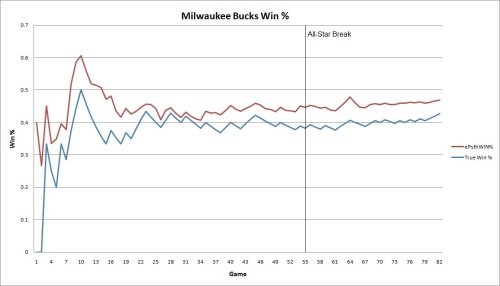Been a long time since I wrote anything here, but I haven’t forgotten my roots.
Over at my Brew Hoop, Frank Madden has been sharing some discussions he had with Dave Deckard of Blazer’s Edge regarding a hypothetical trade proposal (purely hypothetical, people, let’s not get ahead of ourselves just yet). Here’s the deal, in all its beautiful simplicity:
Bucks Receive: SG Wesley Matthews, 2012 First-Round Draft Pick (#11)
Blazers Receive: G Monta Ellis
Let me say first that in John Hammond’s place, I’d go REALLY hard after #6 before sliding back to #11. That’s partially driven by my own value assessment, but there’s also hope you could get the deal sweetened a bit.
The Blazers happen to be one of the few teams where Ellis could conceivably slot in without too much trouble. LaMarcus Aldridge is the only other player who really needs significant offensive touches, and it’s probably easier to accommodate a high-usage G/F combo than G/G. With Matthews’ less-than-friendly contract going to Milwaukee, Portland’s cap situation wouldn’t be at risk. Even if Monta represents an expensive re-sign in the first year of harsher luxury tax penalties, they should have plenty of room to do so without worrying about the financial implications (the wonders of a truly loaded owner). A core of Ellis/LMA/lottery pick/FA would give Portland a good shot at competing in the West for the next few years, especially with the Lakers re-tooling and the Spurs another year older (it has to catch up to them eventually, right?).
For the Bucks, it’s a decent cash-in on Ellis’ value when looked at in context. I’d still say in a pure value sense that Ellis is more valuable than Matthews/#11, but the latter pieces could potentially make the Bucks a better team. The oft-repeated truth is that no team is likely to find a player with the same abilities as Monta Ellis with the #11 pick. Ellis has his flaws, but so does every guard in every draft. You hope those guys can accommodate their weaknesses enough to produce like Ellis can. Most don’t.
That’s where context comes in. While Portland can work around Ellis’ flaws and highlight his strengths, there was a certain level of redundancy in Milwaukee. Not enough size, too many three-point attempts at a low percentage, questionable defense. There’s only so much room for the small and the quick on an NBA team. The second lottery pick might seem like the real prize in this deal, but Wesley Matthews actually accounts for all of those weaknesses.
He’s not a star, but Matthews fits well at the two next to Brandon Jennings. In his Milwaukee stint, SGs opposite Ellis put up a PER of 17.4. Matthews, a solid defender by reputation, gave up a PER of 12.6 to opposing SGs last season. His size alone should keep the Bucks from being abused by bigger backcourts. He’s also a career 39.3% shooter from deep, giving the Bucks much better floor spacing.
There’s obviously going to be some drop-off in athleticism and pure explosiveness should Ellis and Matthews switch places, but a closer look at Matthews’ career reveals some promising facts. In his first two seasons combined, Matthews shot 61.7% at the rim. Then last season, his FG% at the basket plummeted to 49.5%. A drop that significant seems unlikely without some mitigating factors, and a quick look at HoopData’s shot location data reveals a similarly precipitous drop: his assisted-percentage at the rim. Suddenly, Matthews was relying on his own ability to get to the rim and finish, instead of letting his teammates set him up. The Bucks acquired Ellis because he could do what Matthews apparently struggled to do: create his own shot and attack the basket. Would Milwaukee miss that ability if they swap him out?
Not necessarily. If Jennings continues to improve his shooting at the rim and Matthews rebounds to his previous ability, the Bucks will have two serviceable finishers at the guard spots. The Bucks were fourth in the NBA in assisted-percentage at the rim last year, which bodes well for the latter. Combined with better interior scoring, whether acquired through the draft or free-agency, the Bucks could come out of this trade with a more balanced, versatile offense, better equipped for the half-court game that gave them trouble last year. It doesn’t necessarily give you a “core” to work with, but it potentially makes you a better team without too much money tied up in veterans. That allows Kohl and Co. to fulfill their playoff aspirations in the near future while also leaving room for a more thorough rebuilding project.
The financial aspect of the deal is a little trickier for Milwaukee. While getting a young player under team control for the long-term sounds good, Matthews is owed over $20 million in the next three years. Not unreasonable for a good starter, but probably more than Matthews would earn on the open market right now. However, when you factor in the addition of another lottery pick on a cost-controlled deal, it’s easier to reconcile. What’s more, Matthews’ Milwaukee ties make him an easy sell to the fanbase, useful for drumming up interest and ticket sales.
The Bucks might not be ready to cut ties with Ellis; it’s unlikely they traded their franchise center just for the chance to flip the haul a half-season later. And like always, the fate of the roster is tied up in the direction Kohl wants to take the franchise. But this trade idea can certainly be made out as a win-win, satisfying the needs of both franchises while positioning them for future success.
As one last pipe dream, consider this possibility:
1. Trade Monta Ellis to Portland for Wesley Matthews, Shawne Williams, and the #6 pick
2. Draft Harrison Barnes with the #6 pick.
3. Draft a center like Meyers Leonard with the #12 pick.
4. Amnesty Drew Gooden’s contract (or not, if you’d like to keep him in the lineup)
You’re then left with a roster full of young players still on rookie deals, with another year or two to evaluate most of them. You’ve got a potential lineup of Jennings, Matthews, Barnes, and some combination of Sanders, Udoh, and Leonard. If things don’t go well? Play all the young guys and see how things go. You either score another lottery pick or they exceed expectations and make us all happy.
Who’s dropping this one in Hammond’s suggestion box?



Apparently Green Bay can’t support the Packers
November 2, 2011 by Dan Sinclair
I’ve long taken issue with the work of the Wages of Wins Network, mostly in the form of twitter jabs or snide comments in the stuff I write. While the work being done on those sites is admirable, and they’re pursuing a noble goal–richer and more descriptive quantitative analysis of basketball–the prevailing no-questions-asked approach seems to fly in the face of what should be a scientific pursuit.
There’s no doubt an expanded use of advanced statistics and analysis has vastly improved out understanding of basketball. We have better ways of quantifying nearly every measurable event that occurs on the court. But we’re no closer to a Unified Theory of Basketball than physicists are to a Unified Theory of Everything, and yet the faith the WoW Network places in numbers often seems blind and absolute.
It’s one thing to insist again and again that Kevin Love is the best player in the NBA. We can talk all about the eye test offering proof that LeBron James, Dwyane Wade, and perhaps a few others are superior players to Love, but in the end we’re all just sharing opinions based on whatever criteria seem most appropriate. It’s quite another to assert that Green Bay, Wisconsin is incapable of supporting any professional sports team. But that’s exactly the conclusion reached by Arturo Galletti using a metric he devised to gauge a metro area’s capability of doing so. Green Bay is a casualty of a system that simply aggregates a huge amount of money and splits it into a few smaller sums. It’s Win Shares with dollars and cents in the place of rebounds and points.
If you examine the chart, you’ll see that Green Bay lands just barely on the positive side of the “Available Personal Income” divide. However, that calculation saddles Green Bay with only 30 percent of the burden for supporting the Packers. The rest falls on the already stretched thin Milwaukee metro area. In turn, that 70 percent stake in the Packers drives up Milwaukee’s “debt” and makes it the WoW’s number one candidate to have its NBA franchise relocated. If the full cost of supporting the Packers is shifted back to Green Bay, the city falls in the red. Galletti justifies the split by saying “the Packers are very much Milwaukee’s team as well”. But this is true of many franchises, particularly ones that represent a state’s only entry into a particular league. Why is Milwaukee the only one in which the calculations reflect this reality? What’s more, a 70 percent share in the Packers is outrageous. For any metric one could possibly devise, suggesting that any city other than Green Bay could bear a significant majority of the team’s “cost” is just wrong.
The scientific method places tremendous emphasis on falsifiability, and any theory that purports to be comprehensive has to hold in every case. So how have the Packers persisted in Green Bay? How can the tiniest market in the most popular sporting league in the United States compete with 31 other teams and win the Super Bowl? Because it’s about more than money. It’s about a fanbase that supports the team with greater fanaticism than any other. A fanbase that places newborn babies on a 955 year waiting list for season tickets. The Milwaukee Bucks currently lack such support. The Bucks can succeed in Milwaukee if they draft good players, make smart personnel decisions on the roster and in the front office, and play well. If they fail to do so, they will fail no matter which city they call home.
Posted in Commentary | 1 Comment »